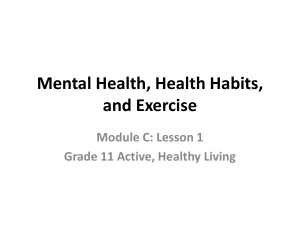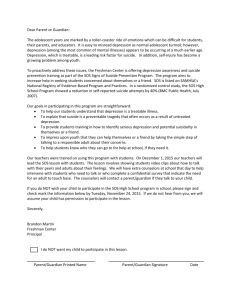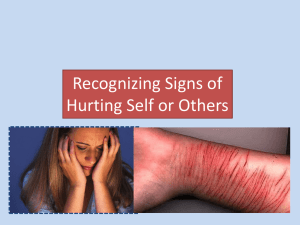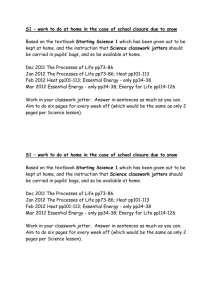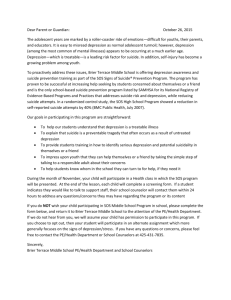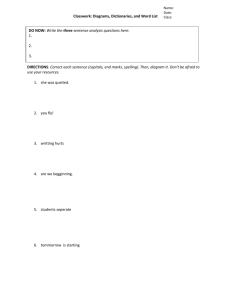Mental-Emotional Health notes - Elliott
advertisement
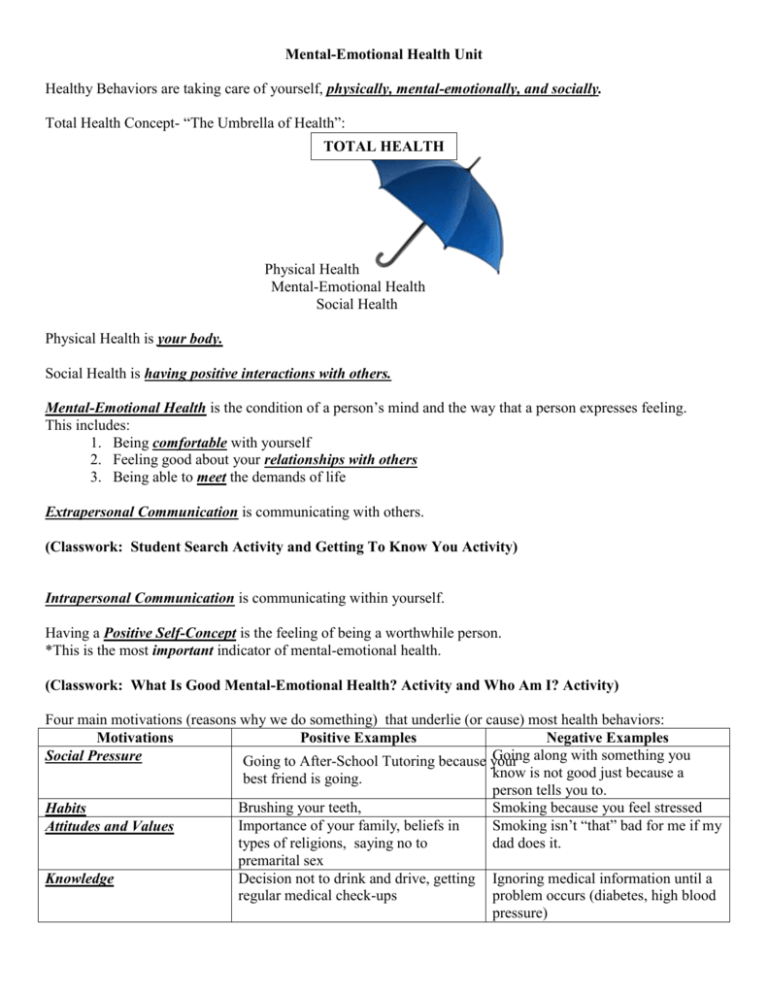
Mental-Emotional Health Unit Healthy Behaviors are taking care of yourself, physically, mental-emotionally, and socially. Total Health Concept- “The Umbrella of Health”: TOTAL HEALTH Physical Health Mental-Emotional Health Social Health Physical Health is your body. Social Health is having positive interactions with others. Mental-Emotional Health is the condition of a person’s mind and the way that a person expresses feeling. This includes: 1. Being comfortable with yourself 2. Feeling good about your relationships with others 3. Being able to meet the demands of life Extrapersonal Communication is communicating with others. (Classwork: Student Search Activity and Getting To Know You Activity) Intrapersonal Communication is communicating within yourself. Having a Positive Self-Concept is the feeling of being a worthwhile person. *This is the most important indicator of mental-emotional health. (Classwork: What Is Good Mental-Emotional Health? Activity and Who Am I? Activity) Four main motivations (reasons why we do something) that underlie (or cause) most health behaviors: Motivations Positive Examples Negative Examples Going along with something you Social Pressure Going to After-School Tutoring because your know is not good just because a best friend is going. person tells you to. Brushing your teeth, Smoking because you feel stressed Habits Importance of your family, beliefs in Smoking isn’t “that” bad for me if my Attitudes and Values types of religions, saying no to dad does it. premarital sex Decision not to drink and drive, getting Ignoring medical information until a Knowledge regular medical check-ups problem occurs (diabetes, high blood pressure) (Classwork: My Personal Coat of Arms Activity – Put your name across the top of the Coat of Arms. Use the remaining 4 squares for each of the four Motivations. Draw a picture to describe what you are experiencing for each Motivation.) (Classwork: Health Habit to Change Activity – What habits do you have? Are some good? Are some bad? What is a health habit that you would like to change about yourself? Remember health is Physical, Mental-Emotional and Social. Use the worksheet to answer the questions about your health habit. Use complete sentences.) The Decision Making Model: 6 Steps D Define the problem Clearly describe the situation E Educate yourself List possible actions Share list and ask for advice Take responsibility for the problem C Consider all options Carefully evaluate each option to see which are safe, reliable, legal, respectful to self and others I Identify your choice Decide which action is responsible and most appropriate D Design a plan and act accordingly E Evaluate your decision Did it work? If not try another solution. Calculated Risk A Calculated Risk is a chance a person takes after carefully thinking about the possible consequences. What to do if you have made a wrong decision: 1. Take responsibility and admit you have made a wrong decision. “It is my fault! I did it. I screwed up. Don’t blame them.” 2. Do not continue actions based on wrong decisions. “I am not going to do that again. That was the last time I make that mistake.” 3. Discuss the wrong decision with a responsible person. 4. Make restitution for harm done to others. “How can I make this up to you? How can I fix this mess? I am sorry, how can I make this better?” Stress Management: Stress is the response of a person’s mind or body to stressors. A Stressor is a physical, mental-emotional, social or environmental demand. General Adaptation Syndrome – the body’s response to stress. Alarm Stage -heart rate increases, breathing increases, muscles tense -the body prepares to meet the demands of the stressor Resistance Stage -Pulse and breathing return to normal -Muscles relax Eustress occurs - SUCCESSFUL coping or healthful response to the stressor Exhaustion Stage -Body fatigues from overwork Distress occurs - UNSUCCESSFUL coping or harmful response to the stressor Life Events and Daily Hassles cause Distress in young people. Examples of Life Events Divorce in the family Births Marriage Death of a friend/family member Money problems Abuse issues in the home Illness of a friend/family member Examples of Daily Hassles Physical appearance Watching or playing in a game Test and other schoolwork Work related problems Stress Management Skills: 1. 2. 3. 4. 5. 6. 7. 8. Talk with a responsible person, parent or other trusted adult. Use responsible decision making skills. Getting enough sleep. Participate in physical activities. Using a time management plan. Writing in a journal. Eating a well balanced diet. Spending time with family and friends. (Classwork: Time Management Plan Activity – Use the Weekly Time Schedule to fill in your activities for the week. Don’t forget school, practice, TV, computer, sleep, meals and chores. Use the Time Management Chart to figure out how much free time you have. Do you use your time wisely?) Depression is the feeling of being sad, unhappy, discouraged and hopeless. Depression is the leading health problem in the U.S. Teenage girls have the highest incidence of depression. Symptoms of Depression: Loss of sleep Loss of appetite Loss of energy Loss of concentration Loss of enthusiasm Sadness Anger Withdrawal from others Dealing with Depression: Spend time with family and friends. Spend time with other adults that may help you. Practice stress management skills daily. Suicide is the intentional taking of one’s life. Indications of possible suicide: Drastic change in personality. Withdrawal from family and friends. Loss of interest. Difficulty getting along with others. Giving away prized possessions. Use of chemicals such as alcohol and marijuana. Verbal or written statements about suicide or death. Suicide Prevention Strategies: Recognize the signs of suicide. Always take the person seriously. Respect confidentiality. Notify a responsible adult. Suicide hotline 410-749-HELP, emergency number 9-1-1. Stay with the person until help arrives. Person will need continued support and encouragement. (Classwork: The 5 Stages of Death and Dying - “After Jimmy” – What symptoms of depression do you notice in Jimmy? The 5 Stages of Death and Dying by Elisabeth Kubler Ross 1. Denial 2. Anger 3. Bargaining 4. Depression 5. Acceptance Look for each stage in the movie. What indications of possible suicide do you notice?)

